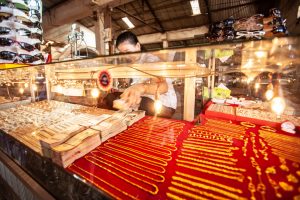The industry’s foreign financial backers are now aware of the scale of the country’s over-indebtedness – but they have lost the ability to do much about it.

A vendor counts banknotes at a gold shop at a market in Koh Kong, Cambodia.
Credit: DepositphotosWestern microfinance investors worried about over-indebtedness in Cambodia are losing the ability to shape the practices of an industry whose rapid growth they helped to foster.
Microfinance in Cambodia started in the 1990s as a form of foreign aid aiming to help rebuild a country recovering from war. It has since grown into a profitable industry, with the number of microfinance borrowers increasing from 175,000 in 2000 to 2.6 million in 2020. The country now has one of the world’s highest rates of microfinance debt relative to personal income.
In Cambodia and elsewhere, microfinance lenders commonly present anecdotal evidence about relatively well-established small businesses benefiting from credit as proof of their “impact.” Academics argue that there is no statistically robust evidence that microfinance lending does any good overall. It is, in fairness, hard for anyone to prove whether or not the success stories would have happened without microfinance. But focusing on the successes ignores the failures, and the human costs to those who are struggling to service their loans.
The average microfinance loan size in Cambodia reached $4,213 in December 2021, according to University of London research,
about double the country’s annual GDP per capita. Rather than helping
people to escape poverty, the research argues, the loans are often the
catalyst for harmful “coping strategies” that are necessary to ensure
repayment. These include borrowing and/or working more, eating less,
selling assets, and leaving farming to work in brick kilns or as
low-skilled migrant laborers in Thailand.
“Most impact investors are concerned about the situation in Cambodia,” says Patrick Goodman, co-founding partner at Innpact, a Luxembourg-based firm which provides advisory and third-party management services to microfinance investors. “Not all microfinance institutions (MFIs) in Cambodia have the client protection principles (CPPs) which ensure lending is done in a responsible way. This is something we are particularly sensitive to.”
Innpact’s largest client is the Microfinance Enhancement Facility (MEF), set up in 2009 by the World Bank’s International Finance Corporation and German state-owned development bank KfW. The MEF reduced its exposure to Cambodia from 11.3 percent of its portfolio in September 2019 to 6.2 percent as of September 2022.
The MEF’s largest investment in the country is in LOLC Cambodia, accounting for 2.5 percent of the portfolio. LOLC Cambodia, set up in 1994 by the non-profit Catholic Relief Service, now has assets of $1.5 billion. It had net income of $53.3 million in 2021, an increase of 17 percent from 2020, even as Cambodians struggled under COVID-19 lockdown restrictions.
The Netherlands-based microfinance investor Oikocredit is among those under attack for its track record. In December, three NGOs – LICADHO, Equitable Cambodia, and FIAN Germany – filed a complaint against Oikocredit with the Dutch government, arguing that the company has failed to carry out proper due diligence on its investments in Cambodia, despite evidence of the harm being caused.
A spokesperson for Oikocredit who declined to be identified said that they are cooperating with the Dutch government’s investigation. Oikocredit, the spokesperson said, works with nine out of 84 Cambodian microfinance institutions and “cannot speak for the whole sector. We know that microcredit is not a panacea, and microfinance cannot replace public social services.”
But the spokesperson did not answer the question of why Cambodian loans are so high in relation to incomes. Neither did they address the question of whether the loans are being used for productive purposes, or simply to meet immediate needs.
Annual lending portfolio growth rates in Cambodia have slowed since 2018, and have since sat at around 22-24 percent, says Sanjay Sinha, managing director of M-CRIL in Gurgaon, India. M-CRIL is currently carrying out an impact assessment study on microfinance in Cambodia due to be published in mid-March.
Investor sentiment has been affected by research and analysis which has “resulted in moderation,” Sinha says. Concern about potential over-indebtedness in Cambodia amongst industry observers in 2016 resulted in the establishment of lending guidelines for the Cambodian market, he says. Belgium-based Impact investment manager Inconfin claims credit for having “pioneered” the initiative. A spokesperson for Inconfin said the organization is “convinced of the positive impact of responsible microfinance and financial inclusion,” but declined to explain why in an interview.
The fact that such guidelines were only created after the extent of the over-indebtedness in Cambodia came to light is a sobering thought. For any future countries on the microfinance impact agenda, the industry may want to decide on what constitutes responsible lending before over-indebtedness arises. In Cambodia, “the market will need to go through a period of stabilization” and MFIs “will have to do some debt cancellation to clean up the market,” says Goodman at Innpact. Sinha argues that the investors who initially backed Cambodian microfinance won’t be able to shape the industry’s future direction. “Western investors by themselves do not exercise significant control of Cambodian microfinance anymore,” with investment sources having shifted to Japan, Taiwan, Singapore, and Thailand, he says.
The Asian Infrastructure Investment Bank in April approved financing of $175 million for the Cambodian microfinance sector. Sinha says that Cambodia’s MFIs are now also able to generate resources from client deposits and are “not dependent on substantial injections of investor funds or international borrowings to finance their growth.” That may be all according to the microfinance industry’s script for growth – but there is still no evidence that Cambodia’s borrowers will be among the beneficiaries.

No comments:
Post a Comment